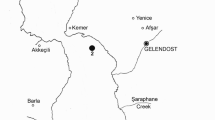Abstract
Bioenergetics models were applied for the assessment of food consumption of northern pike, pikeperch and European catfish in drainable ponds of 0.4 ha. The ponds were stocked with known numbers of the 0+ predators. The prey fish consisted of naturally recruited 0+ cyprinids (rudd, roach and bream). The study shows that the impact of the three 0+ piscivores on the aquatic system differs, which is related to the feeding behaviour and habitat use of the fish. All piscivores realised part of their production on a non-fish diet.
Similar content being viewed by others
References
Barthelmes, D., 1988. Fish predation and resource reaction: Biomanipulation background data from fisheries research. Limnologica (Berlin) 19: 51–59.
Benndorf, J., H. Kneschke, K. Kossatz & E. Penz, 1984. Manipulation of the pelagic food web by stocking with predacious fishes. Int. Revue ges. Hydrobiol. 69: 407–428.
Benndorf, J. (ed.), 1988. Biomanipulation. Limnologica (Berlin) 19: 1–116.
Bevelhimer, M. S., R. A. Stein & R. F. Carline, 1985. Assessing significance of physiological differences among three esocids with a bioenergetics model. Can. J. Fish. aquat. Sci. 42: 57–69.
Beyerle, G. B., 1971. A study of two northern-pike-bluegill populations. Trans. am. Fish. Soc. 100: 69–73.
Beyerle, G. B., 1973. Growth and survival of northern pike in two small lakes containing soft rayed fishes as the principal source of food. Rep. Mich. Dep. Nat. Resour. Fish Div. 1793.
Boeseman, M., 1975. De Nederlandse meerval,Silurus glanis Linnaeus. Zool. Bijdr., Leiden 17: 48–62.
Diana, J. S., 1983. An energy budget for northern pike (Esox lucius). Can. J. Zool. 61: 1968–1975.
Diana, J. S., 1987. Simulation of mechanisms causing stunting in northern pike populations. Trans. am. Fish. Soc. 116: 612–617.
Grimm, M. P., 1983. Regulation of biomass of small (<41 cm) northern pike (Esox lucius L.), with special reference to the contribution of individuals stocked as fingerlings (4–6 cm). Fish. Management 14: 115–134.
Hilge, V., 1985. The influence of temperature on the growth of the European catfish (Silurus glanis L.). Z. angew. Ichthyol. 1: 27–31.
Hosper, S. H., 1989. Biomanipulation, new perspectives for restoration of shallow, eutrophic lakes in the Netherlands. Hydrobiol. Bull. 23: 5–10.
Jobling, M., 1981. Temperature tolerance and the final preferendum-rapid methods for the assessment of optimum growth temperatures. J. Fish Biol. 19: 439–455.
Johnson, B. M., R. A. Stein & R. F. Carline, 1988. Use of a quadrat rotenone technique and bioenergetics modelling to evaluate prey availability to stocked piscivores. Trans. am. Fish. Soc. 117: 127–141.
Kitchell, J. F., D. J. Stewart & D. Weininger, 1977. Applications of a bioenergetics model to yellow perch (Perca flavescens) and walleye (Stizostedion vitrium). J. Fish Res. Bd Can. 34: 1922–1935.
Lammens, E. H. R. R., 1989. Causes and consequences of the success of bream in Dutch eutrophic lakes. Hydrobiol. Bull. 23: 11–18.
Meijer, M.-L., A. J. P. Raat & R. W. Doef, 1989. Restoration by biomanipulation of the Dutch shallow, eutrophic Lake Bleiswijkse Zoom: First results. Hydrobiol. Bull. 23: 49–57.
Minton, J. W. & R. B. MacLean, 1982. Measurements of growth and consumption of sauger (Stizostedion canadense): Implications for fish energetics studies. Can. J. Fish. aquat. Sci. 39: 1396–1403.
Nelder, J. A. & R. Mead, 1965. A simple method for function minimization. Computer Journal 7: 308–313.
Raat, A. J. P., 1978. De meerval,Silurus glanis Linnaeus. OVB-Literatuurrapport. Organisatie ter Verbetering van de Binnenvisserij, Nieuwegein, 29 p.
Raat, A. J. P., 1988. Synopsis of biological data on northern pike (Esox lucius Linnaeus, 1758). FAO Fish. Synopsis, 30 (rev. 2), 178 p.
Schnute, J., 1981. A versatile growth model with statistically stable parameters. Can. J. Fish. aquat. Sci. 38: 1128–1140.
Van Densen, W. L. T., 1985. Piscivory and the development of bimodality in the size distribution of 0+ pikeperch (Stizostedion lucioperca L.). Z. angew. Ichthyol. 1: 119–131.
Van Densen, W. L. T. & M. P. Grimm, 1988. Possibilities for stock enhancement of pikeperch (Stizostedion lucioperca) in order to increase predation on planktivores. Limnologica (Berlin) 19: 45–49.
Willemsen, J., 1977. Influence of temperature on feeding, growth and mortality of pikeperch and perch. Verh. int. Ver. Limnol. 20: 2127–2133.
Walker, P. A., 1989. The feasibility of lake restoration through biomanipulation — a literature study. M&W Aquasense and DBW/RIZA, Amsterdam, Lelystad, 60 p.
Author information
Authors and Affiliations
Rights and permissions
About this article
Cite this article
Raat, A.J.P. Production, consumption and prey availability of northern pike (Esox lucius), pikeperch (Stizostedion lucioperca) and European catfish (Silurus glanis): a bioenergetics approach. Hydrobiologia 200, 497–509 (1990). https://doi.org/10.1007/BF02530367
Issue Date:
DOI: https://doi.org/10.1007/BF02530367




